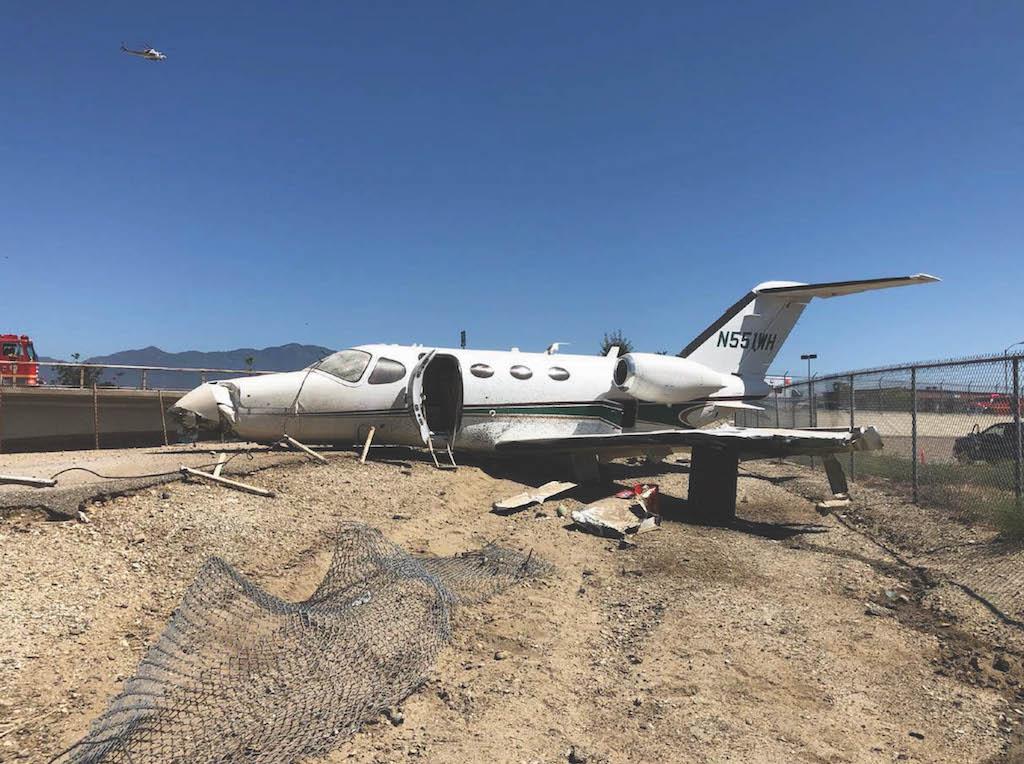
A Cessna 510 Mustang departed from the runway at El Monte-San Gabriel Valley Airport, CA (KEMT) on Aug. 31 2019 after attempting to takeoff with the parking brake set.
This year’s NBAA EBACE in Geneva will take a deep dive into the Global Action Plan for the Prevention of Runway Excursions (GAPRE). The recommendations span the industry and may take time to implement. But there are things we pilots can do right now to reduce the chance of a runway excursion.
Run the numbers. We are taught to predict aircraft takeoff and landing performance using a wide variety of methods. Many of us began with old fashioned “spaghetti charts,” which were time consuming and prone to error. These days we are more likely to feed inputs into computers, which are fast but also prone to error. Either way, the processes basically tell us “yes” or “no.”
Using the wrong aircraft weight or configuration, as well as the wrong environmental conditions can result in a “yes” decision that should be a “no.” I recommend at least two crewmembers compute the data independently, preferably using different methods. The first officer, for example, can use the aircraft flight management computer (FMC) while the captain uses an iPad application. The answers should be reasonably close.
Dealing with a last-minute change that invalidates the planned data can result in rushed data input or pressure to skip the calculations altogether. The solution is to precompute alternatives and to accept delays for unplanned changes. If, for example, an airport has four possible takeoff or landing runway options, it would be wise to calculate the shortest acceptable option and then input the planned option. If a last-minute change puts you on a different runway that is at least as long as your shortest option, you will be able to accept the change with greater confidence. Otherwise, you should ask for a few minutes to “run the numbers.”
Say the numbers. Takeoff runway excursions can be caused by crews failing to configure flaps correctly, failing to set enough thrust, or failing to line up on the correct runway. We can improve our odds by articulating the critical items when programming the FMC, briefing the takeoff, and configuring the aircraft. When programming the numbers, for example, say to the other pilot, “Data is based on 10 degrees of flaps, 98% rated thrust, and Runway 28 full length.” When setting the flaps, instead of saying “flaps set,” articulate the number “10 degrees of flaps.” When lining up on the runway, when you see the runway number on the pavement, say “Runway 28, confirmed.” Each articulation increases your odds of noticing an error. Likewise, articulate the runway number when you see it during landing.
Don’t get cross with the winds. There comes a time in many professional pilot careers where basic stick and rudder skills are assumed and no longer trained. The problem, however, is that we might forget the basics or the basics you learned may no longer apply to the aircraft you are flying. For example, directional control during takeoff in many aircraft requires a three-point attitude until a minimum control speed; unloading the nose wheel early can be a fatal mistake in some aircraft. The old maxim, “ailerons into the wind” during takeoff is usually true but may have limits if spoilers deflect at some point, increasing drag and yaw.
Crosswinds during landing can be especially vexing for pilots moving from one type to another. The “wing low” sideslip is procedure in some aircraft, but a recipe for a wingtip strike or loss of control in others. If these topics are assumed to be understood during your initial training, it is up to you to ask.
Learn to say no. An insidious cause of runway excursions happens many miles before the runway and can take the form of one or more requests from Air Traffic Control. “Maximum forward speed until the marker.” “Proceed direct to the numbers, you’re number one.” “Increase your rate of descent.” “Plan minimum time on the runway.” While we are trained to say “unable,” sometimes we are reluctant to do so, fearing a vector out of the arrival pattern and having to start the process over, reducing our arrival fuel and margin for error. The schoolhouse solution is the stable approach, but in the real world we are prone to rationalize that we can save it in the end. “Hold 200 till the marker” might be doable, but it might not. How do we know?
It may be helpful to construct personal limits on how far you can be pushed before saying “unable.” I won’t exceed 250 knots below 10,000 ft. or 200 kts within 4 nm of a runway, because both those restrictions are based on existing regulations that may or may not be applicable legally, but always apply with me flying. I also refuse to start down on any glide path if I am at a speed that exceeds my landing flap limit or my descent rate exceeds 1,000 ft. per min. If my “unable” gets me sent around, fine. If it happens again and fuel is critical, I will declare an emergency and let any investigations examine just how ATC tried—and failed—to set me up for a runway excursion.
The GAPRE recommendations are well worth reading and are targeted at the entire industry. But we pilots don’t have to wait; there are things we can do right now to prevent the next runway excursion.





